分类问题(classification)概述:
The classification problem is just like the regression problem, except that the values we now want to predict take on only a small number of discrete values. For now, we will focus on the binary classification problem in which y can take on only two values, 0 and 1. (Most of what we say here will also generalize to the multiple-class case.)
分类问题和回归问题有一定的相似性,先从简单的问题二元分类问题(binary classification problem) 入手,因为下面会介绍怎么从二元分类问题转化成多元分类问题。
假设函数(hypothesis function)定义:
Our new form uses the "Sigmoid Function," also called the "Logistic Function":
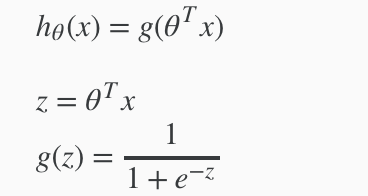
hθ(x) will give us the probability that our output is 1.
![]()
The following image shows us what the sigmoid function looks like:

决策边界(decision boundary):
In order to get our discrete 0 or 1 classification, we can translate the output of the hypothesis function as follows:
![]()
The way our logistic function g behaves is that when its input is greater than or equal to zero, its output is greater than or equal to 0.5:
![]()
Remember.

So if our input to g is \theta^T XθTX, then that means:
![]()
From these statements we can now say:
![]()
The decision boundary is the line that separates the area where y = 0 and where y = 1. It is created by our hypothesis function.
Again, the input to the sigmoid function![]() doesn't need to be linear, and could be a function that describes a circle
doesn't need to be linear, and could be a function that describes a circle ![]() or any shape to fit our data.
or any shape to fit our data.
逻辑回归模型(logistic regression model)选择/代价函数(cost function)定义 :
逻辑回归模型选择参考这篇博客: https://blog.youkuaiyun.com/saltriver/article/details/63683092
我们选择对数模型。Instead, our cost function for logistic regression looks like:


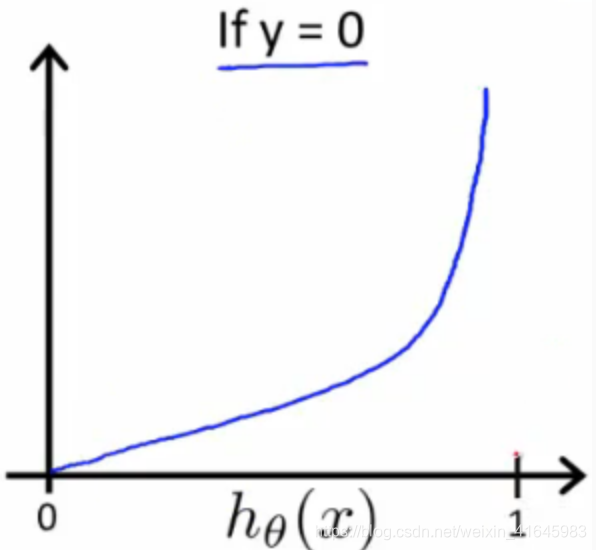

这是一个分段函数,我们可以通过一些技巧合并y=0和y=1这两段函数,从而简化方程式.We can compress our cost function's two conditional cases into one case:
![]()
We can fully write out our entire cost function as follows:
![]()
A vectorized implementation is:

梯度下降(gradient descent)算法的实现 :
Remember that the general form of gradient descent is:
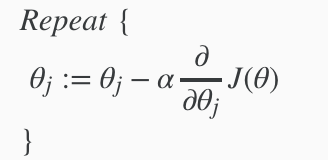
We can work out the derivative part using calculus to get:
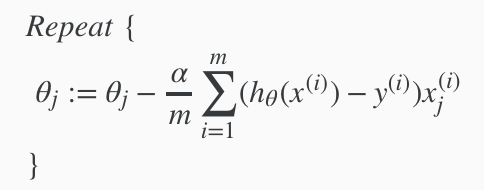
注:公式推导参考这篇博客 https://www.jianshu.com/p/610859e27f66
Notice that this algorithm is identical to the one we used in linear regression. We still have to simultaneously update all values in theta.
A vectorized implementation is:
![]()
更优化的算法:
除了梯度下降算法,还有很多更优的算法来解决逻辑回归分类问题。"Conjugate gradient", "BFGS", and "L-BFGS" are more sophisticated, faster ways to optimize θ that can be used instead of gradient descent.
我们只需要提供下面两个输入值,We first need to provide a function that evaluates the following two functions for a given input value θ:

将两个返回值写到一个函数里面,We can write a single function that returns both of these:

示例代码:
h = sigmoid(X * theta);
J = (-log(h)' * y - log(1 - h)' * (1 - y)) / m;
grad = (X' * (h - y)) ./ m;Octave中实现,Then we can use octave's "fminunc()" optimization algorithm along with the "optimset()" function that creates an object containing the options we want to send to "fminunc()".

示例代码:
% In this exercise, you will use a built-in function (fminunc) to find the
% optimal parameters theta.
% Set options for fminunc
options = optimset('GradObj', 'on', 'MaxIter', 400);
% Run fminunc to obtain the optimal theta
% This function will return theta and the cost
[theta, cost] = ...
fminunc(@(t)(costFunction(t, X, y)), initial_theta, options);
% Print theta to screen
We give to the function "fminunc()" our cost function, our initial vector of theta values, and the "options" object that we created beforehand.
转化成解决多元分类问题(Multiclass Classification: One-vs-all):
Since y = {0,1...n}, we divide our problem into n+1 (+1 because the index starts at 0) binary classification problems; in each one, we predict the probability that 'y' is a member of one of our classes.
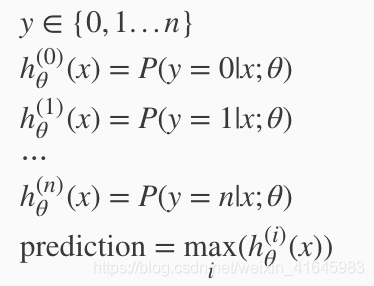
We are basically choosing one class and then lumping all the others into a single second class. We do this repeatedly, applying binary logistic regression to each case, and then use the hypothesis that returned the highest value as our prediction.
当有多个分类时,我们分别选择其中一个分类作为1类,然后将其他的类当成0类,这样计算之后就会有n个h(x)即对于它是(1...n)类的概率,我们选择概率最大的类进行输出。
示例代码:
lambda = 0.1;
for i = 1 : num_labels,
options = optimset('GradObj', 'on', 'MaxIter', 50);
initialTheta = zeros(n + 1, 1);
c = i;
if c == 10,
c = 0;
end;
theta = fmincg (@(t)(lrCostFunction(t, X, (y == c), lambda)), initialTheta, options);
all_theta(i, :) = theta';
% fprintf('%dX%d\n', size(theta, 1), size(theta, 2));
% fprintf('%dX%d\n', size(all_theta, 1), size(all_theta, 2));
end;





 本文深入探讨了分类问题的基本概念,重点介绍了二元分类问题,并详细解释了逻辑回归模型如何通过使用Sigmoid函数预测输出为1的概率。文章还讨论了决策边界的概念,以及如何通过梯度下降算法优化模型参数。
本文深入探讨了分类问题的基本概念,重点介绍了二元分类问题,并详细解释了逻辑回归模型如何通过使用Sigmoid函数预测输出为1的概率。文章还讨论了决策边界的概念,以及如何通过梯度下降算法优化模型参数。
















 965
965

 被折叠的 条评论
为什么被折叠?
被折叠的 条评论
为什么被折叠?








